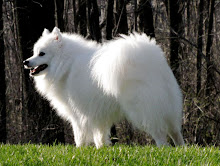March 4, 2010
The evolutionary diet of wolves and wild dogs historically consisted of almost all protein. This was when the main concern was procreation. Since the canine evolved into more of a domesticated companion, the concern became longevity. Science has taught us that there is a myriad of benefits in feeding fruits and vegetables to your dog, not the least of which is a long and healthy life.
Even so, when preparing a meal for Rover, you'll want to make sure it contains no less than 45% - 50% protein, as protein is still a very important part of the canine diet.
A simple formula to follow is this:
- 50% protein (beef, lamb, pork, chicken, turkey, eggs, fish, etc.)
- 25% fresh or frozen vegetables/fruits (carrots, broccoli, green peas, celery, zucchini, melons, apples, bananas, pears, etc.)
- 25% starch (oatmeal, potatoes, sweet potatoes, pasta, rice, etc.)
- calcium - 1/2 teaspoon per pound of fresh food (ground egg shells, seaweed, bone meal, oyster shells, etc.)
Meats
Japanese Spitz can have sensitive stomachs at times. Our dogs, for example, get an upset stomach if they eat certain rich meats like lamb and buffalo. If your dog has an overly sensitive stomach, poultry may be the best option for you. Eggs are a great healthy alternative as well. Fish has beneficial omega-3 fatty acids, however, it is better to stay away from albacore tuna due to its high mercury content.
Vegetables
Always feed a variety of different vegetables to keep the meals interesting and to ensure your dog is benefiting from the different nutrients various vegetables provide.
Non-starchy vegetables will need to be cooked or pureed to be digested by your dog. Whole and/or raw vegetables won't hurt your dog, but they don't provide the needed nutritional benefit. A vegetable's cell wall is made of a "protectant" called cellulose, and has to be broken down to reach the nutrients on the inside. We, as humans, do this by chewing. We have flat molars, which are made for exactly this. Dogs, however, have sharp, scissor-like teeth, made for tearing through raw meat. They use the "Bite and Swallow" method of eating, rather than chewing their food. This is why it is necessary to cook or puree the non-starchy vegetables you feed. Doing this will break down those cell walls, freeing the nutrients for absorption into your dog's body. The best way to cook non-starchy vegetables is by steaming because fewer nutrients are lost this way.
Starchy vegetables should always be cooked before feeding them to your dog. The best way to cook these vegetables is by baking or microwaving.
Fruits
Fruits can be fed raw. Overripe fruits are the easiest for your dog to digest. In the summer time, our dogs like when I blend various fruits in my blender and freeze them in muffin tins. Please remember that you should NEVER FEED GRAPES OR RAISINS TO YOUR DOG, as they are known to cause kidney failure, which can be fatal.
Calcium
It is very unfortunate that calcium is often overlooked in the homemade canine diet, because no diet is complete and balanced without it. High-protein foods, which make up the majority of your dogs homemade diet, contain large amounts of phosphorus. Balancing the calcium-phosphorus combination is vital. If calcium and phosphorus are not properly balanced in the diet, the body pulls calcium from the dog's bones to make up for the deficiency, leaving them weakened. There should always be more calcium then phosphorus. The recommended ratios for dogs range from 1-to-1 to 2-to-1 calcium to phosphorus.
I have found the easiest way to add calcium to our dogs' food is by grinding clean, dry eggshells in a clean coffee grinder. The shells are ground into a fine, easy-to-absorb powder. If the shells are kept dry, they will last indefinitely and there is no need to refrigerate them. 1/2 teaspoon of ground eggshell provides approx. 1,000 milligrams of calcium. This is the amount you should add to every pound of fresh food. If you feed a combination diet, add only enough calcium to match the fresh food portion of the diet.
If you choose to use oyster shells or bone meal to add calcium to your dog's diet, look for brands that state they have been tested for lead and found to be safe. Lead is a harmful contamination that is often found in these items.
IMPORTANT: Do not add more calcium than necessary. Even though adult dogs typically excrete excess calcium, calcium can bind many other minerals, which decreases the nutritional value of what you feed. Also, puppies less than 6 months old have less of an ability to control how much calcium their bodies absorb. A calcium excess in puppies can lead to skeletal problems such as hip dysplasia, hypertrophic osteodystrophy, and osteochondrosis. Lastly, pregnant females who are given an excess of calcium can develop a life-threatening condition called eclampsia when they begin nursing. It's fine to increase the calcium after the puppies are born, just don't increase calcium prior to whelping.
skip to main |
skip to sidebar

Geisha, Sami, and Ju-Ju (waiting for a treat)



(7 weeks old)

(7 weeks old)






"Psssst . . . I need to tell you a secret . . . "
This blog is created by and for Japanese Spitz lovers. Sweet Samurai is a small, home-based kennel in TN. We have three JS & created this blog to help provide continual support to our friends who purchase our grandpuppies, as well as anyone who owns/loves JS. If you would like information regarding our dogs, please visit our website at www.sweetsamurai.com or e-mail us at SweetSamuraiKennels@gmail.com. To receive this blog via e-mail, type your address in the subscription field below.
Search This Blog
E-MAIL SUBSCRIPTIONS
Our Three Babies

Geisha, Sami, and Ju-Ju (waiting for a treat)
Blog Archive
-
►
2008
(12)
- ► November 2008 (8)
- ► December 2008 (4)
-
►
2009
(57)
- ► January 2009 (5)
- ► February 2009 (1)
- ► March 2009 (4)
- ► April 2009 (1)
- ► August 2009 (8)
- ► September 2009 (7)
- ► October 2009 (5)
- ► November 2009 (7)
- ► December 2009 (5)
-
▼
2010
(36)
- ► January 2010 (10)
- ► February 2010 (8)
- ▼ March 2010 (3)
- ► August 2010 (2)
- ► October 2010 (3)
-
►
2011
(25)
- ► February 2011 (1)
- ► March 2011 (4)
- ► April 2011 (3)
- ► August 2011 (3)
Past Blog Entries - ASPCA tips
Past Blog Entries - Teaching Basic Commands
Past Blog Entries - First Aid in the Field
Past Blog Entries - Caring For Your Senior
Past Blog Entries - Cooking For Canines
Past Blog Entries - Indoor Brain Games
Past Blog Entries - Treat Recipes for your Dog
Geisha & Sami (January, 2008)

Ju-Ju (12 weeks old)

Sasuke (from our first litter)

(7 weeks old)
Izzy and Yuki (from our first litter)

(7 weeks old)
Other Interesting Links
- American Rare Breed Association
- American Society for the Provention of Cruelty to Animals
- Best Friends Animal Society
- Dogpile.com - a search engine that helps rescue pets
- Japanese Spitz Club of America
- Pet Food Recalls
- Pet Products Containing Lead
- Sweet Samurai Kennels Official Website
- Sweet Samurai Videos
- The Japanese Spitz (according to Pedigree.com)
- The Japanese Spitz Kennel Club Book
- United Kennel Club
- Yoshi (A grandpuppy from our May, 2008 litter)
Recommended References and Reading
- Japanese Spitz Kennel Club Book by Michael Rule
- The Japanese Spitz by Marco G. Piasentin
- Vet Confidential; An Insider's Guide to Protecting your Pet's Health by Louise Murray, D.V.M.
- First Aid for Dogs; What to do When Emergencies Happen by Bruce Fogle, D.V.M.
- Marley and Me: Life and Love with the World's Worst Dog by John Grogan
Ju-Ju and Sami

Reputable U.S. Japanese Spitz Breeders
Little Ju-Ju

Izzy (a puppy from our May, 2008 litter)

Kona (puppy from May, 2008 litter)
Ju-Ju (January, 2009)


"Psssst . . . I need to tell you a secret . . . "
Site Disclaimer: The information contained in this site is general in nature and has been researched and compiled from a variety of sources. It is not a substitute for professional veterinary care, and is not meant to replace the advice of veterinary care professionals. If you have specific veterinary needs, or for complete information about your dog(s), please see a veterinarian. Readers of this blog agree that neither Sweet Samurai Kennels, nor its owners have any liability with respect to any actions taken as a result of or in connection with viewing any information contained on this site. You agree to use this site and the information presented at your own risk. Some areas of our site may provide links to other external sites that we don't own, control or influence. We reference sites that we think might be useful or of interest to you, but we are not responsible for the content or privacy practices used by other site owners. Information contained in the external sites is not endorsed by Sweet Samurai Kennels, nor its owners. It is simply offered as a service to our visitors.


